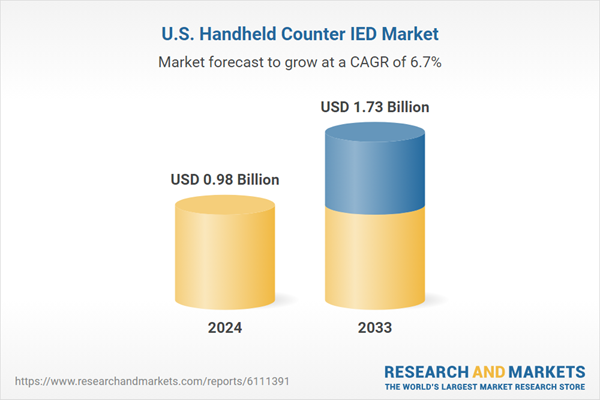U.S. Handheld Counter IED Market Trends
The U.S. handheld counter IED market size was estimated at USD 0.98 billion in 2024 and is projected to grow at a CAGR of 6.7% from 2025 to 2033. The persistent use of improvised explosive devices (IEDs) by insurgent groups and lone actors continues to pose a major security threat, particularly in conflict zones and urban environments. The U.S. military and homeland security agencies are actively investing in handheld C-IED technologies to neutralize threats in real time and prevent mass casualties. These devices offer immediate deployability and situational flexibility, which are crucial for on-ground counterterrorism operations. The market is being driven by the need for lightweight, rugged, and rapidly deployable detection tools suited for unpredictable environments.Rapid detection technology innovations are transforming handheld C-IED systems' performance and usability. Today’s devices are no longer limited to one type of sensor; instead, they combine electromagnetic field detection, chemical trace sensors, infrared imaging, and acoustic analysis to provide a multi-modal approach to explosive threat detection. Artificial Intelligence (AI) and machine learning are being integrated to analyze sensor data in real time, reducing the rate of false alarms and improving threat classification. Enhanced data connectivity allows field operators to transmit findings to command centers for further analysis or remote support. Miniaturization of components has made these devices more lightweight and ergonomic, increasing adoption among foot soldiers and tactical teams. With these advancements, the market is seeing a shift toward smart, adaptive handheld systems that not only detect threats but also provide actionable insights on the nature and potential impact of the explosive device
The growing application of handheld C-IED devices in civilian security and urban counterterrorism efforts. Airports, seaports, mass transit systems, sporting events, and government buildings have become potential soft targets for IED attacks. Consequently, federal and municipal agencies such as the Transportation Security Administration (TSA), Department of Homeland Security (DHS), and local police bomb squads are increasing their investment in portable explosive detection tools. These devices are designed for intuitive use by first responders, often requiring minimal training while maintaining high accuracy. The expansion of C-IED usage into civilian domains has also triggered the development of more ruggedized, user-friendly, and cost-effective solutions.
Federal investment and institutional support play a vital role in accelerating the adoption of handheld C-IED technologies. U.S. defense and security agencies-including the Department of Defense (DoD), JIDO, DHS, and various intelligence and customs authorities-have allocated substantial budgets toward counter-IED programs. These funds are directed toward both R&D efforts for next-generation detection systems and bulk procurement to equip frontline operatives across the country. Government solicitations frequently specify compactness, multi-threat detection capability, battery efficiency, and compatibility with existing tactical gear, driving suppliers to innovate on both form and function.
Tactical mobility and enhanced soldier safety are pivotal concerns influencing handheld C-IED system development. Modern military and law enforcement units require tools that can be easily carried, deployed quickly, and operated under stressful conditions. Handheld systems offer this flexibility, unlike vehicle-mounted or large-scale equipment, which may be constrained by terrain or environment. The latest models are designed with ergonomic grips, heads-up display interfaces, and modular attachments for integration with tactical vests or helmets. Some systems can also be paired with UAVs (drones) or robotic arms for remote scanning, further reducing operator risk.
U.S. Handheld Counter IED Market Report Segmentation
This report forecasts revenue growth at country level and provides an analysis of the latest industry trends in each of the sub-segments from 2021 to 2033. For this study, the analyst has segmented the U.S. handheld counter IED market report based on product type, detection technology, application, and end use:Product Type Outlook (Revenue, USD Million, 2021 - 2033)
- Portable Detectors
- Handheld Scanners
- Smartphone Based Detectors
Detection Technology Outlook (Revenue, USD Million, 2021 - 2033)
- Electromagnetic Field Detection
- Infrared Detection
- Acoustic Detection
- Chemical Detection
Application Outlook (Revenue, USD Million, 2021 - 2033)
- Military
- Homeland Security
- Law Enforcement
- Civilian
End Use Outlook (Revenue, USD Million, 2021 - 2033)
- Government Agencies
- Defense Contractors
- Non-Governmental Organizations
Why should you buy this report?
- Comprehensive Market Analysis: Gain detailed insights into the global market across major regions and segments.
- Competitive Landscape: Explore the market presence of key players worldwide.
- Future Trends: Discover the pivotal trends and drivers shaping the future of the global market.
- Actionable Recommendations: Utilize insights to uncover new revenue streams and guide strategic business decisions.
This report addresses:
- Market intelligence to enable effective decision-making
- Market estimates and forecasts from 2018 to 2030
- Growth opportunities and trend analyses
- Segment and regional revenue forecasts for market assessment
- Competition strategy and market share analysis
- Product innovation listing for you to stay ahead of the curve
- COVID-19's impact and how to sustain in these fast-evolving markets
This product will be delivered within 1-3 business days.
Table of Contents
Companies Mentioned
- L3Harris Technologies, Inc.
- Lockheed Martin Corporation
- Northrop Grumman Corporation
- Raytheon Technologies Corporation
- General Dynamics Corporation
- Thales Group
- Chemring Group PLC
- Elbit Systems Ltd.
- BAE Systems PLC
- Sierra Nevada Corporation
Table Information
| Report Attribute | Details |
|---|---|
| No. of Pages | 100 |
| Published | June 2025 |
| Forecast Period | 2024 - 2033 |
| Estimated Market Value ( USD | $ 0.98 Billion |
| Forecasted Market Value ( USD | $ 1.73 Billion |
| Compound Annual Growth Rate | 6.7% |
| Regions Covered | United States |
| No. of Companies Mentioned | 10 |









